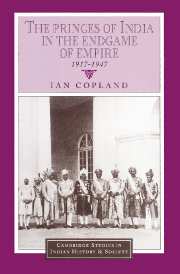Introduction
Published online by Cambridge University Press: 30 October 2009
Summary
Any account of the last days of princely rule will sound incredible today.
K. M. Panikkar, 1977When India's government-owned international airline was set up in the 1950s, one of the first things its directors had to do was choose a company logo – an arresting icon for its stationery and billboards. It is significant (though not without irony) that among the many resonant national symbols that must have leapt to mind, they hit upon – not a Bengal tiger, or a sacred cow or a chakra – but: the salaaming, pugreed figure of a king. This was the airline, the caption ran, ‘that treats you like a maharaja’. Now the choice of a turbaned prince certainly made good business sense, the figure being a part of India's image abroad and thus easily recognisable to potential tourists. Beyond that, however, the choice reflected another, deeper reality: kings and kingship were, and are, a vital part of India's cultural baggage. In the modern nation-state which is the Republic of India, royalty, in the abstract, remains a rich and potent source of inspiration and political legitimacy.
Yet (and this is the ironical bit) maharajas – as such – no longer exist. Between 1947 and 1949 all 600-odd ruling princes in India were pensioned off and their ancestral domains – the so-called ‘princely states’ – were submerged in the body politic of the Indian union. Nowadays the few former rulers still alive are just ordinary citizens; while the ex-states survive – if at all – only in attenuated shape as components of larger administrative units. As a practical system of governance monarchy in India has been consigned to the dustbin of history.
- Type
- Chapter
- Information
- Publisher: Cambridge University PressPrint publication year: 1997

